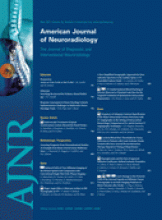Research ArticlePediatric Neuroimaging
Selectively Reduced Posterior Corpus Callosum Size in a Population-Based Sample of Young Adults Born with Low Birth Weight
S.M. Aukland, R. Westerhausen, K.J. Plessen, M.D. Odberg, I.B. Elgen, B.S. Peterson, L. Ersland, G.E. Eide and K. Rosendahl
American Journal of Neuroradiology May 2011, 32 (5) 970-975; DOI: https://doi.org/10.3174/ajnr.A2594
S.M. Aukland
R. Westerhausen
K.J. Plessen
M.D. Odberg
I.B. Elgen
B.S. Peterson
L. Ersland
G.E. Eide

References
- 1.↵
- Kramer MS
- 2.↵
- 3.↵
- 4.↵
- Rademaker KJ,
- Lam JNGP,
- van Haastert IC,
- et al
- 5.↵
- Fearon P,
- O'Connell P,
- Frangou S,
- et al
- 6.↵
- Stewart AL,
- Rifkin L,
- Amess PN,
- et al
- 7.↵
- Cooke RW,
- Abernethy LJ
- 8.↵
- Nosarti C,
- Rushe TM,
- Woodruff PWR,
- et al
- 9.↵
- Luders E,
- Narr KL,
- Bilder RM,
- et al
- 10.↵
- Narberhaus A,
- Segarra D,
- Caldu X,
- et al
- 11.↵
- Caldu X,
- Narberhaus A,
- Junque C,
- et al
- 12.↵
- Griffiths PD,
- Batty R,
- Reeves MJ,
- et al
- 13.↵
- 14.↵
- Pujol J,
- Vendrell P,
- Junque C,
- et al
- 15.↵
- Allin M,
- Henderson M,
- Suckling J,
- et al
- 16.↵
- Anderson NG,
- Laurent I,
- Cook N,
- et al
- 17.↵
- 18.↵
- Sommerfelt K,
- Ellertsen B,
- Markestad T
- 19.↵
- Elgen I,
- Sommerfelt K
- 20.↵
- Elgen I,
- Sommerfelt K,
- Markestad T
- 21.↵
- Odberg MD,
- Sommerfelt K,
- Markestad T,
- et al
- 22.↵
- Witelson SF
- 23.↵
- 24.↵
- Smith RJ
- 25.↵
- Bland JM,
- Altman DG
- 26.↵
- Cohen J
- 27.↵
- Peterson BS,
- Vohr B,
- Staib LH,
- et al
- 28.↵
- Skranes JS,
- Martinussen M,
- Smevik O,
- et al
- 29.↵
- O'Brien LM,
- Ziegler DA,
- Deutsch CK,
- et al
- 30.↵
- Jancke L,
- Staiger JF,
- Schlaug G,
- et al
- 31.↵
- Nosarti C,
- Al-Asady MH,
- Frangou S,
- et al
- 32.↵
- Nosarti C,
- Giouroukou E,
- Healy E,
- et al
- 33.↵
- Allin M,
- Nosarti C,
- Narberhaus A,
- et al
- 34.↵
- Langmeier M,
- Pokorny J,
- Mares J,
- et al
- 35.↵
- Nagy Z,
- Ashburner J,
- Andersson J,
- et al
- 36.↵
- Kontis D,
- Catani M,
- Cuddy M,
- et al
- 37.↵
- Hart AR,
- Whitby EW,
- Griffiths PD,
- et al
In this issue
Advertisement
S.M. Aukland, R. Westerhausen, K.J. Plessen, M.D. Odberg, I.B. Elgen, B.S. Peterson, L. Ersland, G.E. Eide, K. Rosendahl
Selectively Reduced Posterior Corpus Callosum Size in a Population-Based Sample of Young Adults Born with Low Birth Weight
American Journal of Neuroradiology May 2011, 32 (5) 970-975; DOI: 10.3174/ajnr.A2594
0 Responses
Selectively Reduced Posterior Corpus Callosum Size in a Population-Based Sample of Young Adults Born with Low Birth Weight
S.M. Aukland, R. Westerhausen, K.J. Plessen, M.D. Odberg, I.B. Elgen, B.S. Peterson, L. Ersland, G.E. Eide, K. Rosendahl
American Journal of Neuroradiology May 2011, 32 (5) 970-975; DOI: 10.3174/ajnr.A2594
Jump to section
Related Articles
- No related articles found.
Cited By...
This article has not yet been cited by articles in journals that are participating in Crossref Cited-by Linking.
More in this TOC Section
Similar Articles
Advertisement











